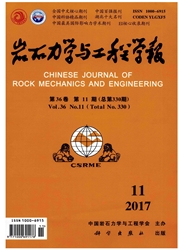

 中文摘要:
中文摘要:
在现场节理调查中,采用圆形窗口直接进行节理调查并不实用。将所有的迹线类型设计成统一的数据结构,读取现场测量的数据;然后在生成的节理迹线图上布置圆形取样窗口。根据测量数据的具体情况调整圆形取样窗口的位置、数量和半径,同时判断并记录每个圆形取样窗口对应的各种迹线类型的数量。利用圆形窗口法原理。在估计节理迹线平均长度的同时计算出节理迹线中点面密度。对于实际测量数据,节理迹线中点并非均匀分布,选择恰当的圆形窗口位置和半径,才能得出合理的结果。采用同心圆法和相切圆法对岌岌采石场岩体节理的平均迹长和迹线中点面密度进行估计,分析表明采用相切圆法能够得出稳定且具有一致性的结果。利用该法计算出中国高放废物处置库甘肃北山预选区域岌岌采石场断裂两侧露头的平均迹长和迹线中点面密度,分析断裂对两侧岩体节理影响的范围。
 英文摘要:
英文摘要:
Circular sample window method is not applicable for joint surveying in field. A uniform data structure is designed for joint data of all trace types. The joint trace map is drawn according to field surveying data, and circular sample windows are arranged on the joint trace map. The position, quantity and radius of the circular windows are adjusted to the specific conditions of surveying data. Simultaneously, the quantity of different trace types in the same circle is identified and recorded. Based on the circular sample window method theory, the trace midpoint density of joint is obtained to estimate the mean trace length. The distribution of the trace midpoint is not uniform, and it is far from being insignificant for reasonable results that position and radius of circular sample window are selected appropriately. Concentric circle method and tangent circle method are applied to estimating the mean trace length and the trace midpoint density in Jiji quarry. It indicates that tangent circle method is stable and reasonable. The joint data, which are surveyed in the candidate region of high radioactive waste in Beishan Mount, Gansu Province, China, are analyzed with tangent circle method. As a result, the influence range of the fault is concluded by analyzing the mean trace length and the trace midpoint density of joint on the both sides of the fault.
 同期刊论文项目
同期刊论文项目
 同项目期刊论文
同项目期刊论文
 期刊信息
期刊信息
